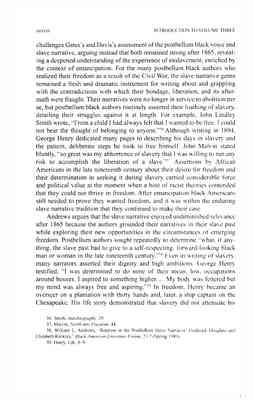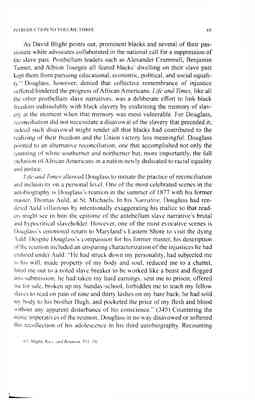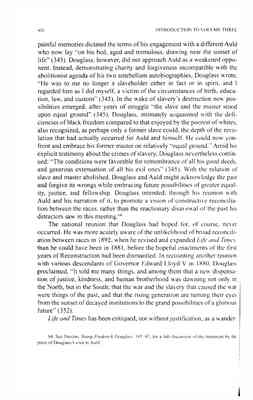Pages
26
xxxviii INTRODUCTION TO VOLUME THREE
challenges Gates's and Davis's assessment of the postbellum black voice and slave narrative, arguing instead that both remained strong after 1865, revealing a deepened understanding of the experience of enslavement, enriched by the context of emancipation. For the many postbellum black authors who realized their freedom as a result of the Civil War, the slave narrative genre remained a fresh and dramatic instrument for writing about and grappling with the contradictions with which their bondage, liberation, and its aftermath were fraught. Their narratives were no longer in service to abolition per se, but postbellum black authors routinely asserted their loathing of slavery, detailing their struggles against it at length. For example, John Lindley Smith wrote, "From a child I had always felt that I wanted to be free. I could not bear the thought of belonging to anyone."56 Although writing in 1894, George Henry dedicated many pages to describing his days in slavery and the patient, deliberate steps he took to free himself. John Malvin stated bluntly, "so great was my abhorrence of slavery that I was willing to run any risk to accomplish the liberation of a slave."57 Assertions by African Americans in the late nineteenth century about their desire for freedom and their determination in seeking it during slavery carried considerable force and political value at the moment when a host of racist theories contended that they could not thrive in freedom. After emancipation black Americans still needed to prove they wanted freedom, and it was within the enduring slave narrative tradition that they continued to make their case.
Andrews argues that the slave narrative enjoyed undiminished relevance after 1865 because the authors grounded their narratives in their slave past while exploring their new opportunities in the circumstances of emerging freedom. Postbellum authors sought repeatedly to determine "what, if anything, the slave past had to give to a self-respecting, forward-looking black man or woman in the late nineteenth century."58 Even in writing of slavery, many narrators asserted their dignity and high ambitions. George Henry testified, "I was determined to do none of their mean, low, occupations around houses, I aspired to something higher.... My body was fettered but my mind was always free and aspiring."59 In freedom, Henry became an overseer on a plantation with thirty hands and, later, a ship captain on the Chesapeake. His life story demonstrated that slavery did not attenuate his
5656. Smith, Autobiography, 29.
5757. Malvin, North into Freedom, 44 .
5858. William L. Andrews, "Reunion in the Postbellum Slave Narrative: Frederick Douglass and Elizabeth Keckley." Black American Literature Forum, 23:7 (Spring 1989).
5959. Henry, Life, 8- 9.
27
INTRODUCTION TO VOLUME THREE xxxix
desire and capacity for freedom; perhaps more significantly, it attested to his constructive participation, as a free man, in middle-class society. Henry Clay Bruce's narrative addressed this reality yet more comprehensively:
These slaves knew their own helpless condition. They also knew that they had no rights under the laws of the land, and that they were, by those same laws, the chattels of their masters, and that they owed them their services during their natural lives, and that the masters alone could make their lives pleasant or miserable. But having superior blood in their veins, they did not give up in abject servility, but held up their heads and proceeded to do the next best thing under the circumstances, which was, to so live and act as to win the confidence of their masters, which could only be done by faithful service and an upright life.... Such slaves were to be found wherever the institution of slavery existed, and when they were freed by the war, these traits which they had exhibited for generations to such good effect, were brought into greater activity, and have been largely instrumental in making the record of which we feel so proud to-day.60
The experience of enslavement determined, to a great extent, the experience and course of post-emancipation freedom; indeed, that freedom could not have been properly understood without a full examination of enslavement. The slave narrative remained the essential discursive vehicle for promoting an understanding of freedom because it alone could emphasize the fact that dignity and utility were often acquired within the institution of slavery. Antebellum narratives rarely admitted this possibility, inimical to their agenda of immediate abolition. In freedom, black authors could reevaluate the experience of slavery, adjusting the lens of the traditional slave narrative. Freed authors exploited the irony of their slavery as an argument for black freedom, citing their bondage as the source of "the record of which we feel so proud to-day." As Andrews writes, "the agenda of the postbellum slave narrative thus emphasizes unabashedly the tangible contribution that blacks made to the South, in and after slavery, in order to rehabilitate the image of the freedman, not the idea of slavery, in the eyes of business America."61
Douglass's time in slavery, especially his later childhood in Baltimore,
6060. Bruce, New Man, 39.
6161. Andrews, "Reunion in the Postbellum Slave Narrative," 14. See also William L. Andrews, "The Representation of Slavery and the Rise of Afro-American Literary Realism, 1865–1920," in Slavery and the Literary Imagination ed. Deborah E. McDowell and Arnold Rampersad (Baltimore, 1989), 62–80.
28
INTRODUCTION TO VOLUME THREE xi
enabled him to acquire skills such as literacy, proper speech, and etiquette that would allow him to function effectively in freedom, but his circumstances in slavery were hardly typical. Admitting his advantages would have dulled the impact of his first narrative, but even his postbellum adjustments to the antebellum descriptions of his slave years seem minor compared to the dramatic reappraisals authored by Bruce and others. Along with most postbellum narrators, Douglass argued for the primacy of black activism after 1865 and refused to allow the memory of slavery to be sentimentalized or suppressed in order to bind North and South together again. By the 1880s the nation's long fatigue with the struggles and violence of Reconstruction merged with mounting northern doubts about the propriety of having freed a people commonly portrayed as ill equipped to manage that freedom. This doubt engendered a popular enthusiasm for a reconciliation of North and South founded on acceptance of the post-Reconstruction political status quo and erasure of the antebellum ideological conflicts. Oppression of African Americans, at the core of the Civil War's bloody battles, became the first mnemonic casualty of reconciliation. Suppression of his race's claims to full citizenship was precisely what Douglass feared when, on 5 July 1875, he asked his Washington, D.C., audience, "If war among the whites brought peace and liberty to the blacks, what will peace among the whites bring?"62 In Life and Times he presents an argument against the national amnesia he anticipated as the postbellum years unfolded:
I have written out my experience here, not to exhibit my wounds and bruises to awaken and attract sympathy to myself personally, but as a part of the history of a profoundly interesting period in American life and progress. l have meant it to be a small individual contribution to the sum of knowledge of this special period.... The time is at hand when the last American slave, and the last American slaveholder will disappear behind the curtain which separates the living from the dead, and when neither master nor slave will be left to tell the story of their respective relations.... My part has been to tell the story of the slave. The story of the master never wanted for narrators. They have had all the talent and genius that wealth and influence could command to tell their story.... If I have pushed my example too prominently for the good taste of my Caucasian readers I beg them to remember that I have written in part for the encouragement of a class whose aspirations need the stimulus of success. (372- 73)
6262. "The Color Question," 5 July 1875, in Douglass Papers, ser. 1, 4:417.
29
INTRODUCTION TO VOLUME THREE xii
As David Blight points out, prominent blacks and several of their passionate white advocates collaborated in the national call for a suppression of the slave past. Postbellum leaders such as Alexander Crummell, Benjamin Tanner, and Albion Tourgee all feared blacks' dwelling on their slave past kept them from pursuing educational, economic, political, and social equality.63 Douglass, however, denied that collective remembrance of injustice suffered hindered the progress of African Americans. Life and Times, like all the other postbellum slave narratives, was a deliberate effort to link black freedom indissolubly with black slavery by enshrining the memory of slavery at the moment when that memory was most vulnerable. For Douglass, reconciliation did not neccssitate a disavowal of the slavery that preceded it; indeed such disavowal might render all that blacks had contributed to the realizing of their freedom and the Union victory less meaningful. Douglass pointed to an alternative rcconciliation, one that accomplished not only the reuniting of white southerner and northerner but, more importantly, the full inclusion of African Americans in a nation newly dedicated to racial equality and justice.
Life and Times allowed Douglass to initiate the practice of reconciliation and inclusivity on a personal level. One of the most celebrated scenes in the autobiography is Douglass's reunion in the summer of 1877 with his former master, Thomas Auld, at St. Michaels. In his Narrative, Douglass had rendered Auld villainous by intentionally exaggerating his malice so that readers might see in him the epitome of the antebellum slave narrative's brutal and hypocritical slaveholder. However, one of the most evocative scenes is Douglass's emotional return to Maryland's Eastern Shore to visit the dying Auld. Despite Douglass's compassion for his former master, his description of the reunion included an unsparing characterization of the injustices he had endured under Auld: "He had struck down my personality, had subjected me to his will, made property of my body and soul, reduced me to a chattel, hired me out to a noted slave breaker to be worked like a beast and flogged into submission; he had taken my hard earnings, sent me to prison, offered me for sale, broken up my Sunday-school, forbidden me to teach my fellow slaves to read on pain of nine and thirty lashes on my bare back; he had sold my body to his brother Hugh, and pocketed the price of my flesh and blood without any apparent disturbance of his conscience." (345) Countering the irenic imperatives of the reunion, Douglass in no way disavowed or softened this recollection of his adolescence in his third autobiography. Recounting
6363. Blight, Race and Reunion, 311–19.
30
xiii INTRODUCTION TO VOLUME THREE
painful memories dictated the terms of his engagement with a different Auld who now lay "on his bed, aged and tremulous, drawing near the sunset of life" (345). Douglass, however, did not approach Auld as a weakened opponent. Instead, demonstrating charity and forgiveness incompatible with the abolitionist agenda of his two antebellum autobiographies, Douglass wrote, "He was to me no longer a slaveholder either in fact or in spirit, and I regarded him as I did myself, a victim of the circumstances of birth, education, law, and custom" (345). In the wake of slavery's destruction new possibilities emerged; after years of struggle "the slave and the master stood upon equal ground" (345). Douglass, intimately acquainted with the deficiencies of black freedom compared to that enjoyed by the poorest of whites, also recognized, as perhaps only a former slave could, the depth of the revolution that had actually occurred for Auld and himself. He could now confront and embrace his former master on relatively "'equal ground." Amid his explicit testimony about the crimes of slavery, Douglass nevertheless continued: 'The conditions were favorable for remembrance of all his good deeds, and generous extenuation of all his evil ones" (345). With the relation of slave and master abolished, Douglass and Auld might acknowledge the past and forgive its wrongs while embracing future possibilities of greater equality, justice, and fellowship. Douglass intended, through his reunion with Auld and his narration of it, to promote a vision of constructive reconciliation between the races, rather than the reactionary disavowal of the past his detractors saw in this meeting.64
The national reunion that Douglass had hoped for, of course, never occurred. He was more acutely aware of the unlikelihood of broad reconciliation between races in 1892, when he revised and expanded Life and Times, than he could have been in 1881, before the hopeful enactments of the first years of Reconstruction had been dismantled. In recounting another reunion with various descendants of Governor Edward Lloyd V in 1880, Douglass proclaimed, "It told me many things, and among them that a new dispensation of justice, kindness, and human brotherhood was dawning not only in the North, but in the South; that the war and the slavery that caused the war were things of the past, and that the rising generation are turning their eyes from the sunset of decayed institutions to the grand possibilities of a glorious future" (352).
Life and Times has been critiqued, not without justification, as a wander-
6464. See Preston, Young Frederick Douglass, 187-97, for a full discussion of the treatment by the press of Douglass's visit to Auld.




